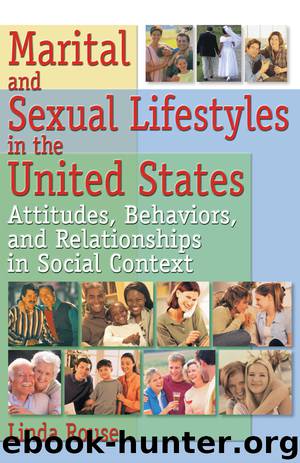Marital and Sexual Lifestyles in the United States by Linda P. Rouse

Author:Linda P. Rouse
Language: eng
Format: epub
Publisher: Routledge
Source: Matousek 1993.
Compulsive sexual behaviors are estimated to affect 5 percent of all adult Americans (Rosellini 1995: 209). Harrison and Kellogg (1992) observed, however, that there is little public recognition of sexual addiction. (In fact, some counseling professionals also dismiss the concept of addiction as applied to sexual conduct.) The problem of sexual addiction runs against an inclination to see sex as pleasurable and to avoid dictating another person’s sexuality. Unwillingness to confront sexual addiction as a social problem may also reflect denial of one’s own compulsive sexual behaviors and/or personal victimization. Our culture reinforces some sexual addictions that, in effect, become the norm—as in public fascination with the president’s sex life or fixation on women’s breast size. Given beliefs that pleasure is good, more is better, life is short, and you only live once, an individual’s focus on sex can be mistaken for self-confidence and athletic prowess; observers do not necessarily notice the desperate, callous, and exploitative element in sexually addicted behavior.
A main feature of compulsive sexual behaviors is the lack of options experienced. Addiction decreases choice and ultimately results in unsatisfactory outcomes. Sex is used for a release, to avoid tensions and feelings of powerlessness, but in a way that generates shame, numbness, and alienation. One reformed sex addict observed that despite an “unceasing parade of lovers,” intimacy was lacking. The habit had been formed of reducing oneself and others to objects, which left a feeling of loneliness and lack of connection no matter how frequently one had sex. Matousek (1995) theorizes that sexual addiction begins with a desire for love, not self-destructiveness. Sexual addiction is common among persons sexually abused as children, who therefore formed unhealthy associations and obsessions around sex. In “crazy” families, the child is left unable to distinguish between appropriate and inappropriate sexual expression, when desire is trouble and when to stop. He or she learns bad feels good and vice versa (Matousek 1995: 181). Matousek gave the example of a man who had been forced to perform fellatio on his father as a child, resulting in a sexual fixation compelling him to repeat the behavior with hundreds of men. Early abuse and bad models of sexuality at both extremes of overt demonstration and intense repression set the stage for emotional dissociation.
Recovery from sexual addiction involves a commitment to stop and participation in counseling or self-help groups. Twelve-step or other therapeutic programs that emphasize stopping destructive behavior and gaining spiritual strength can help sex addicts lead a normal life (Matousek 1995). The twelve-step addiction recovery model adds a spiritual interpretation alongside psychotherapy and behavior modification. Sexually compulsive behaviors are not defined as moral weakness or perversion, but are understood instead as a replacement behavior, reenactment of childhood abuse or misdirected efforts to compensate for needed love and spiritual connection. Though a period of celibacy is useful for self-evaluation, the solution for sexual addiction is not permanent abstinence, but a different form of “sobriety.” Persons recovering from sexual addition struggle with acknowledging activities that are
Download
This site does not store any files on its server. We only index and link to content provided by other sites. Please contact the content providers to delete copyright contents if any and email us, we'll remove relevant links or contents immediately.
Rewire Your Anxious Brain by Catherine M. Pittman(18551)
Talking to Strangers by Malcolm Gladwell(13219)
The Art of Thinking Clearly by Rolf Dobelli(10210)
Mindhunter: Inside the FBI's Elite Serial Crime Unit by John E. Douglas & Mark Olshaker(9186)
Becoming Supernatural by Dr. Joe Dispenza(8119)
Change Your Questions, Change Your Life by Marilee Adams(7633)
Nudge - Improving Decisions about Health, Wealth, and Happiness by Thaler Sunstein(7612)
The Road Less Traveled by M. Scott Peck(7522)
The Lost Art of Listening by Michael P. Nichols(7403)
Enlightenment Now: The Case for Reason, Science, Humanism, and Progress by Steven Pinker(7228)
Mastermind: How to Think Like Sherlock Holmes by Maria Konnikova(7221)
Win Bigly by Scott Adams(7094)
The Way of Zen by Alan W. Watts(6503)
Daring Greatly by Brene Brown(6443)
Big Magic: Creative Living Beyond Fear by Elizabeth Gilbert(5610)
Grit by Angela Duckworth(5512)
Ego Is the Enemy by Ryan Holiday(5292)
Men In Love by Nancy Friday(5155)
Altered Sensations by David Pantalony(5043)
